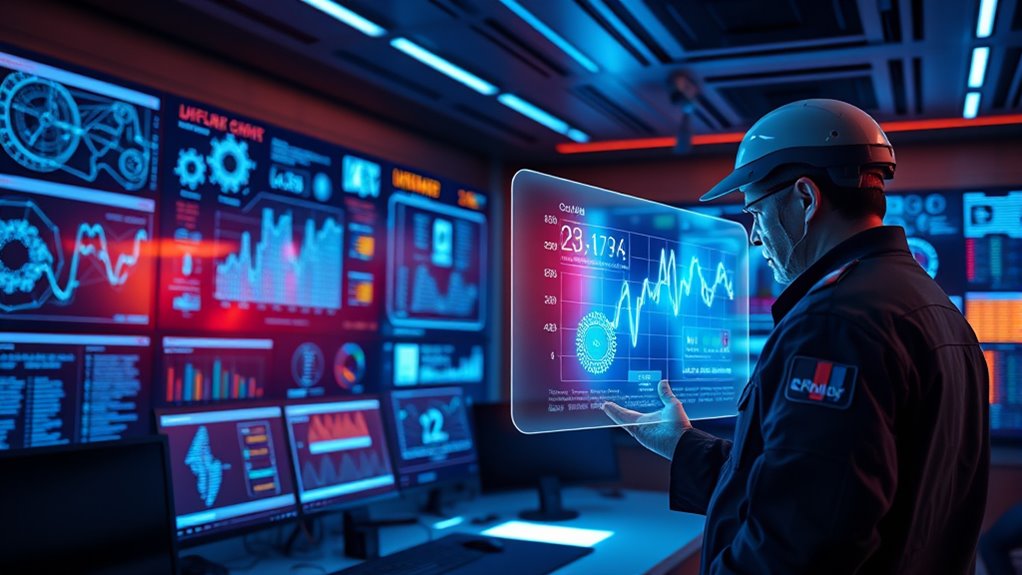AI fortifies your industrial control system security by detecting anomalies and suspicious activities in real time, helping you spot potential cyberattacks early. It automates responses to contain threats quickly, reducing damage and downtime. With advanced algorithms analyzing vast data, AI improves risk management and guarantees compliance. Layered security measures and continuous updates keep your system resilient against evolving threats. Keep exploring to discover how these technologies can safeguard your operations effectively.
Key Takeaways
- AI enables real-time anomaly detection and threat identification in ICS environments.
- Automated AI-driven responses quickly contain vulnerabilities and mitigate cyber threats.
- Machine learning analyzes sensor data to predict failures and ensure operational safety.
- Continuous AI monitoring supports compliance and reduces manual security audits.
- Layered security and regular model updates enhance AI resilience against adversarial attacks.

In today’s increasingly connected industrial environments, securing control systems against cyber threats is more critical than ever. You need advanced tools that can detect, analyze, and respond to malicious activities swiftly. AI plays a vital role here by enhancing threat detection capabilities. It identifies anomalies and suspicious activities in real-time, allowing you to spot potential cyberattacks early. Through continuous monitoring and sophisticated algorithms, AI can recognize complex patterns that might escape traditional security measures, giving you an edge in defending your systems.
AI also markedly improves risk management. By analyzing vast amounts of data from sensors, network traffic, and operational logs, AI helps you understand potential vulnerabilities and prioritize mitigation efforts. This proactive approach reduces the likelihood of successful attacks and minimizes downtime. When a threat is detected, AI systems can trigger automated responses, drastically reducing reaction times. This autonomous response capability ensures that threats are contained quickly, limiting possible damage and maintaining system stability.
Processing and analyzing large data streams is another essential function AI offers. It provides insights into system performance and security status, enabling you to make informed decisions. Whether it’s identifying patterns indicating an impending failure or uncovering subtle signs of malicious activity, AI helps you stay ahead of evolving threats. Additionally, AI supports regulatory compliance by continuously monitoring and analyzing data to meet legal and safety standards. This reduces the burden of manual audits and ensures your operations align with industry requirements. Employing advanced analytics enhances your capability to interpret complex data sets effectively.
In terms of threat detection techniques, AI employs machine learning algorithms to analyze data for anomalies and potential threats. Deep learning models handle more complex detection tasks, such as analyzing network traffic for unusual patterns. It’s crucial to design AI systems that can detect adversarial attacks—those that manipulate AI models—by implementing layered security protocols and ongoing model retraining. Continuous monitoring of your ICS environment guarantees threats are identified and addressed promptly, with AI validating sensor data to prevent false alarms. Moreover, establishing robust security protocols is essential to safeguard AI systems from potential exploits.
Guaranteeing AI security involves maintaining data integrity to prevent hallucinations that could lead to incorrect decisions. Layered security measures protect AI systems from adversarial efforts, while regular model retraining keeps the AI effective against new threats. Developing comprehensive incident response plans ensures you’re prepared to handle security breaches involving AI. Compliance with regulations is also essential, as it maintains trust and ensures legal adherence. Additionally, integrating AI with existing security frameworks ensures a cohesive defense against emerging cyber threats. Building resilience in AI systems through robust security measures is fundamental to maintaining operational integrity.
Integrating AI into your ICS operations enhances efficiency and reliability. It enables real-time decision-making, automates routine tasks, and supports predictive maintenance—reducing downtime and operational costs. Ultimately, leveraging AI for ICS security empowers you to build resilient, adaptive, and secure industrial environments capable of facing modern cyber threats head-on. Regular model retraining helps maintain the effectiveness of AI systems against evolving adversarial tactics.
Frequently Asked Questions
How Does AI Adapt to Evolving Cyber Threats in Industrial Environments?
You might wonder how systems adapt to changing cyber threats. AI handles this by analyzing patterns in your environment and learning from previous incidents. It updates its threat models continuously with new data, allowing it to recognize subtle anomalies and evolving attack techniques. This ongoing learning process helps your security measures stay ahead of threats, making your defenses smarter and more resilient over time.
What Are the Key Challenges in Deploying AI Across Diverse Control Systems?
You face key challenges when deploying AI across diverse control systems. You must handle integration complexity due to heterogeneous components and different protocols. Data quality and security issues hinder effective AI training and operation. Cyber threats increase with AI integration, demanding robust defenses. Ensuring operational reliability and gaining trust requires transparency and continuous validation. Balancing these factors, you need tailored solutions that adapt to various hardware, network constraints, and safety requirements.
How Does AI Impact the Latency of Real-Time Industrial Security Responses?
Think of AI as your security watchtower—its impact on response latency is like a double-edged sword. It reduces delays by processing data at the edge, enabling faster detection and automated responses. You benefit from quicker threat identification and guided actions, often in minutes rather than hours. But, if not properly optimized, AI can also introduce slight delays, so balancing security and speed remains vital for real-time industrial responses.
What Are the Ethical Considerations of Using AI for Critical Infrastructure Security?
You need to consider the ethical implications of deploying AI in critical infrastructure security. It’s vital to ensure accountability, protect privacy, and prevent misuse or bias. You should follow clear governance frameworks involving multiple stakeholders to balance innovation with ethical safeguards. Prioritize transparency and responsible data handling, and continuously monitor AI systems to avoid harm, discrimination, or privacy violations—because safeguarding civil rights and maintaining public trust are essential.
How Is AI Integrated With Existing Industrial Cybersecurity Protocols?
Think of your cybersecurity protocols as a fortress, and AI as the vigilant guard patrolling its walls. You integrate AI by aligning it with your governance, policies, and standards, ensuring it follows compliance and risk management frameworks. It actively monitors network traffic, detects anomalies, and responds automatically to threats. This seamless integration strengthens your defenses, making your security measures smarter, faster, and more adaptive to the ever-changing landscape of cyber threats.
Conclusion
As you harness AI to protect industrial control systems, you stand at the forefront of innovation, blending human intuition with machine intelligence. While legacy vulnerabilities may linger like shadows, AI’s proactive defenses act as a beacon of security. Together, you create a resilient future—where technology and vigilance unite—turning potential chaos into calm. In this dance of risk and response, your efforts make certain of safety amidst the ever-evolving digital landscape.











